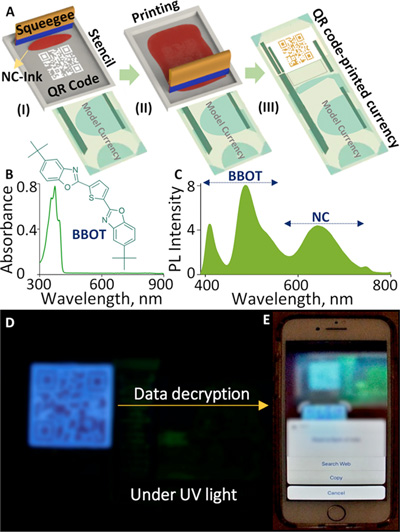| Mar 22, 2021 |
Luminescent QR security labels based on nanoclusters
(Nanowerk News) Stable solid-state emitting, atomically precise nanoclusters with high photoluminescence quantum yield are promising materials for developing large-area printable electronics, mainly for security prints, wearable LEDs, and healthcare sensors.
|
|
To achieve this goal, the key criterion is to fabricate a smart luminescent nanocluster-based ink having adequate consistency for printing, preserved photoluminescence and molecular stability, and flexibility for multiple usages.
|
|
The development of such a nanocluster-based luminescent printing ink is still in its infancy and in order to address this challenge, researchers in India have fabricated a stable, flexible, nontoxic, and low-cost nanocluster-based luminescent ink by integrating solid-state emitting nanoclusters in an elastic matrix.
|
|
The team reports their findings in ACS Applied Materials & Interfaces ("Light-Emitting Atomically Precise Nanocluster-Based Flexible QR Codes for Anticounterfeiting")
|
|
A QR code is a machine-readable two-dimensional barcode, which can encrypt data such as name, website URL, address, phone number, location details, and so on. The information encoded on these optical labels can be accessed by scanning with a camera-enabled mobile device having a QR code scanner application.
|
|
In their work, the researchers have successfully shown the room temperature fabrication of nontoxic, cost-effective, reliable, and optically unclonable luminescent security labels. They demonstrated their technique by printing a QR code on banknotes.
|
 |
| (A) Schematic representation of the stencil printing technique used to print QR code on a banknote. (B) Absorption spectrum and chemical structure of BBOT. (C) Combined PL spectrum recorded from a mixture of NCs and BBOT. Photographs of the (D) QR code-printed currency and (E) data decryption process using a smartphone under UV light. The photograph of the QR codeprinted original currency has been blurred to avoid copyright issues. (Reprinted with permission by American Chemical Society) (click on image to enlarge)
|
|
Such security labels are fabricated through stencil printing technology using near NIR-emitting precise nanoclusters as the primary component in ink. The printed security labels are stable over a range of temperatures, under a spectrum of lights, humidity, and mechanical stress.
|
|
The printed QR code is readable only under UV light and can be read out with a smartphone..
|
|
The estimated overall cost of a security label is approximately 0.013 USD per stamp.
"The exceptional mechanical, thermal, photo, and aqueous stability of the printed documents suggest that nanocluster-based luminescent ink can be further extended to develop the next-level security codes," the researchers conclude.
|

 By
Michael
Berger
– Michael is author of three books by the Royal Society of Chemistry:
Nano-Society: Pushing the Boundaries of Technology,
Nanotechnology: The Future is Tiny, and
Nanoengineering: The Skills and Tools Making Technology Invisible
Copyright ©
Nanowerk LLC
By
Michael
Berger
– Michael is author of three books by the Royal Society of Chemistry:
Nano-Society: Pushing the Boundaries of Technology,
Nanotechnology: The Future is Tiny, and
Nanoengineering: The Skills and Tools Making Technology Invisible
Copyright ©
Nanowerk LLC
